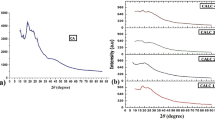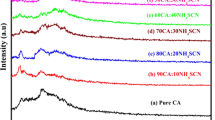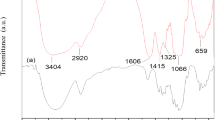Abstract
The current investigation involves the preparation of solid biopolymer electrolytes using the Solution Casting method using cellulose acetate with various concentrations of LiClO4. The prepared membranes are subjected for X-ray diffraction (XRD) analysis in order to analyze the crystalline/amorphous nature. The complex formation between cellulose acetate and LiClO4 has been established using the Fourier transform infrared technique (FTIR). The Li-ionic conductivity of the examined membranes is determined through AC Impedance measurement. The membrane, comprising 1 g of cellulose acetate with 0.5 molecular weight percentage (M wt.%) of LiClO4, exhibits the highest lithium-ion conductivity among the prepared membranes. The conductivity is determined to be 3.95 × 10−3 S cm−1. The glass transition temperature of the prepared membranes is determined using Differential scanning calorimetry (DSC), while their thermal stability is analyzed through Thermo gravimetric analysis (TGA). The electrochemical stability of the highest conducting membrane has been analyzed using Linear sweep voltammetry (LSV), and the potential window is found to be 3.1 V. Furthermore, the cyclic stability of the highest ion conducting membrane is investigated by Cyclic voltammetry (CV). The focus of the current investigation highlights the performance of Li-ion conducting membrane as electrolyte in electrochemical devices.













Similar content being viewed by others
Data availability
The datasets generated during and/or analyzed during the current study are not publicly available due to the manuscript has not yet been published but are available from the corresponding author on reasonable request.
References
Aziz SB, Nofal MM, Abdulwahid RT, Kadir MFZ, Hadi JM, Hessien MM, Saeed SR (2021) Impedance, FTIR and transport properties of plasticized proton conducting biopolymer electrolyte based on chitosan for electrochemical device application. Results Phys 29(11):104770
Hallinan DT, Balsara NP (2013) Annual review of materials research. In Annual Reviews, Palo Alto (Vol. 43)
Aafrin Hazaana S, Joseph A, Selvasekarapandian S, Meera Naachiyar R, Vengadesh Krishna M, Muniraj Vignesh N (2022) Development and characterization of biopolymer electrolyte based on gellan gum (GG) with lithium chloride (LiCl) for the application of electrochemical devices. Polymer Bull. 80(12):1–21
Fuzlin AF, Saadiah MA, Yao Y, Nagao Y, Samsudin AS (2020) Enhancing proton conductivity of sodium alginate doped with glycolic acid in bio-based polymer electrolytes system. J Polym Res 27:1–16
Perumal P, Christopher Selvin P, Selvasekarapandian S (2018) Characterization of biopolymer pectin with lithium chloride and its applications to electrochemical devices. Ionics 24:3259–3270
Nithya M, Alagar M, Sundaresan B (2020) Eco-friendly biopolymer kappa carrageenan with NH4Br application in energy saving battery. Mater Lett 263:127295
Serra JP, Fidalgo-Marijuan A, Teixeira J, Hilliou L, Gonçalves R, Urtiaga K, Costa CM (2022) Sustainable lithium-ion battery separator membranes based on carrageenan biopolymer. Adv Sustain Syst 6(12):2200279
Monisha S, Mathavan T, Selvasekarapandian S, Benial AMF, Latha MP (2017) Preparation and characterization of cellulose acetate and lithium nitrate for advanced electrochemical devices. Ionics 23(10):2697–2706
Ramesh S, Shanti R, Morris E (2013) Employment of [Amim] Cl in the effort to upgrade the properties of cellulose acetate-based polymer electrolytes. Cellulose 20:1377–1389
Chitra R, Sathya P, Selvasekarapandian S, Meyvel S (2020) Synthesis and characterization of iota-carrageenan biopolymer electrolyte with lithium perchlorate and succinonitrile (plasticizer). Polym Bull 77(3):1555–1579
Muchakayala R, Song S, Gao S, Wang X, Fan Y (2017) Structure and ion transport in an ethylene carbonate-modified biodegradable gel polymer electrolyte. Polym Testing 58:116–125
Sampathkumar L, Christopher Selvin P, Selvasekarapandian S, Perumal P, Chitra R, Muthukrishnan M (2019) Synthesis and characterization of biopolymer electrolyte based on tamarind seed polysaccharide, lithium perchlorate and ethylene carbonate for electrochemical applications. Ionics 25:1067–1082
Perumal P, Selvin PC, Selvasekarapandian S, Sivaraj P (2019) Structural and electrical properties of bio-polymer pectin with LiClO4 solid electrolytes for lithium ion polymer batteries. Mater Today: Proc 8:196–202
Hazaana SA, Joseph A, Selvasekarapandian S, Naachiyar RM, Vignesh NM (2022) Performance of solid-state Li-ion conducting battery using biopolymer electrolyte based on agar–agar/lithium chloride. J Solid State Electrochem 1–19
Vanitha N, Shanmugapriya C, Selvasekarapandian S, Krishna MV, Nandhini K (2022) Investigation of N-S-based graphene quantum dot on sodium alginate with ammonium thiocyanate (NH4SCN) biopolymer electrolyte for the application of electrochemical devices. J Mater Sci: Mater Electron 33(18):14847–14867
Heinze J (1984) Cyclic voltammetry “electrochemical spectroscopy”. New analytical methods (25). Angewandte Chemie Int Ed English 23(11):831–847
Nirmala Devi G, Chitra S, Selvasekarapandian S, Premalatha M, Monisha S, Saranya J (2017) Synthesis and characterization of dextrin-based polymer electrolytes for potential applications in energy storage devices. Ionics 23(12):3377–3388
Ramesh S, Shanti R, Morris E (2013) Characterization of conducting cellulose acetate based polymer electrolytes doped with “green” ionic mixture. Carbohyd Polym 91(1):14–21
Hodge RM, Edward GH, Simon GP (1996) Water absorption and states of water in semicrystalline poly (vinyl alcohol) films. Polymer 37(8):1371–1376
Moniha V, Alagar M, Selvasekarapandian S, Sundaresan B, Boopathi G (2018) Conductive bio-polymer electrolyte iota-carrageenan with ammonium nitrate for application in electrochemical devices. J Non-Cryst Solids 481:424–434
Mahalakshmi M, Selvanayagam S, Selvasekarapandian S, Moniha V, Manjuladevi R, Sangeetha P (2019) Characterization of biopolymer electrolytes based on cellulose acetate with magnesium perchlorate (Mg(ClO4)2) for energy storage devices. J Sci: Adv Mater Devices 4(2):276–284
Selvakumar M, Bhat DK (2008) LiClO4 doped cellulose acetate as biodegradable polymer electrolyte for supercapacitors. J Appl Polym Sci 110(1):594–602
Sudiarti T, Wahyuningrum D, Bundjali B, Arcana IM (2017) Mechanical strength and ionic conductivity of polymer electrolyte membranes prepared from cellulose acetate-lithium perchlorate. In IOP Conference Series: Materials Science and Engineering. IOP Publishing. 223(1):012052
Monisha S, Mathavan T, Selvasekarapandian S, Benial AMF, Aristatil G, Mani N, Premalatha M (2017) Investigation of bio polymer electrolyte based on cellulose acetate-ammonium nitrate for potential use in electrochemical devices. Carbohyd Polym 157:38–47
Monisha S, Selvasekarapandian S, Mathavan T, Milton Franklin Benial A, Manoharan S, Karthikeyan S (2016) Preparation and characterization of biopolymer electrolyte based on cellulose acetate for potential applications in energy storage devices. J Mater Sci: Mater Electron 27:9314–9324
Sim LH, Gan SN, Chan CH, Yahya RJSAPAM (2010) ATR-FTIR studies on ion interaction of lithium perchlorate in polyacrylate/poly (ethylene oxide) blends. Spectrochim Acta Part A Mol Biomol Spectrosc 76(3–4):287–292
Vanitha N, Shanmugapriya C, Selvasekarapandian S, Naachiyar RM, Krishna MV, Aafrin Hazaana S, Ramaswamy M (2022) Effect of graphene quantum dot on sodium alginate with ammonium formate (NH4HCO2) biopolymer electrolytes for the application of electrochemical devices. Ionics 28(6):2731–2749
Naachiyar MR, Ragam M, Selvasekarapandian S, Aristatil G, Hazaana AS, Vignesh MN, Krishna VM (2022) Fabrication of rechargeable proton battery and PEM fuel cell using biopolymer Gellan gum incorporated with NH4HCO2 solid electrolyte. J Polymer Res 29(8):337
Mahalakshmi M, Selvanayagam S, Selvasekarapandian S, Chandra ML, Sangeetha P, Manjuladevi R (2020) Magnesium ion-conducting solid polymer electrolyte based on cellulose acetate with magnesium nitrate (Mg (NO3) 2· 6H2O) for electrochemical studies. Ionics 26(9):4553–4565
Fuzlin AF, Samsudin AS (2021) Studies on favorable ionic conduction and structural properties of biopolymer electrolytes system-based alginate. Polym Bull 78(4):2155–2175
Aziz SB, Brza MA, Hamsan HM, Kadir MFZ, Abdulwahid RT (2021) Electrochemical characteristics of solid state double-layer capacitor constructed from proton conducting chitosan-based polymer blend electrolytes. Polym Bull 78:3149–3167
Anbazhakan K, Selvasekarapandiyan S, Monisha S, Premalatha M, Neelaveni A (2017) Lithium ion conductivity and dielectric properties of P (VdCl-co-AN-co-MMA)-LiCl-EC triblock co-polymer electrolytes. Ionics 23:2663–2668
Jayabalakrishnan SS, Selvasekarapandian S, Aafrin Hazaana S, Kavitha P, Vengadesh Krishna M (2023) Proton-conducting Moringa oleifera seed-based biomaterial electrolyte for electrochemical applications. Ionics 29(1):331–344
Arockia Mary I, Selvanayagam S, Selvasekarapandian S, Chitra R, Leena Chandra MV, Ponraj T (2020) Lithium ion conducting biopolymer membrane based on K-carrageenan with LiNO3. Ionics 26:4311–4326
Ravi M, Song S, Wang J, Wang T, Nadimicherla R (2016) Ionic liquid incorporated biodegradable gel polymer electrolyte for lithium ion battery applications. J Mater Sci: Mater Electron 27:1370–1377
Selvalakshmi S, Vijaya N, Selvasekarapandian S, Premalatha M (2017) Biopolymer agar-agar doped with NH4SCN as solid polymer electrolyte for electrochemical cell application. J Appl Polymer Sci 134(15):44702
Aziz SB, Woo TJ, Kadir MFZ, Ahmed HM (2018) A conceptual review on polymer electrolytes and ion transport models. J Sci: Adv Mater Devices 3(1):1–17
Nofal MM, Aziz SB, Hadi JM, Abdulwahid RT, Dannoun EM, Marif AS, Kadir MFZ (2020) Synthesis of porous proton ion conducting solid polymer blend electrolytes based on PVA: CS polymers: structural, morphological and electrochemical properties. Materials 13(21):4890
Kamal H, Abd-Elrahim FM, Lotfy S (2014) Characterization and some properties of cellulose acetate-co-polyethylene oxide blends prepared by the use of gamma irradiation. J Radiat Res Appl Sci 7(2):146–153
Arthanareeswaran G, Thanikaivelan P, Srinivasn K, Mohan D, Rajendran M (2004) Synthesis, characterization and thermal studies on cellulose acetate membranes with additive. Eur Polymer J 40(9):2153–2159
Pinto MDCE, da Silva DD, Gomes ALA, Leite VDSA, e Moraes ARF, de Novais RF, Pinto FG (2019) Film based on magnesium impregnated biochar/cellulose acetate for phosphorus adsorption from aqueous solution. RSC Adv 9(10):5620–5627
Bhuvaneswari B, Sivabharathy M, Prasad LG, Selvasekarapandian S (2022) Structural, thermal and electrochemical characterization of cellulose acetate–based solid biopolymer electrolyte for zinc ion batteries. Ionics 28(8):3865–3875
Elgrishi N, Rountree KJ, McCarthy BD, Rountree ES, Eisenhart TT, Dempsey JL (2018) A practical beginner’s guide to cyclic voltammetry. J Chem Educ 95(2):197–206
Chitra R, Sathya P, Selvasekarapandian S, Monisha S, Moniha V, Meyvel S (2019) Synthesis and characterization of iota-carrageenan solid biopolymer electrolytes for electrochemical applications. Ionics 25(5):2147–2157
Aziz SB, Asnawi AS, Abdulwahid RT, Ghareeb HO, Alshehri SM, Ahamad T, Hadi JM, Kadir MF (2021) Design of potassium ion conducting PVA based polymer electrolyte with improved ion transport properties for EDLC device application. J Market Res 13:933–946
Aziz SB, Nofal MM, Abdulwahid RT, Kadir MF, Hadi JM, Hessien MM, Kareem WO, Dannoun EM, Saeed SR (2021) Impedance, FTIR and transport properties of plasticized proton conducting biopolymer electrolyte based on chitosan for electrochemical device application. Results in Physics 29:104770
Lee WG, Kim DH, Jeon WC, Kwak SK, Kang SJ, Kang SW (2017) Facile control of nanoporosity in cellulose acetate using nickel (II) nitrate additive and water pressure treatment for highly efficient battery gel separators. Sci Rep 7(1):1287
Aziz SB, Abdullah OG, Abdulwahid RT, Ahmed MJ, Tahir HB, Saeed SR, Kadir MF (2023) EDLC Performance of plasticized NBG electrolyte inserted with Ba (NO3) 2 salt: impedance, electrical and electrochemical properties. Electrochim Acta 43134
Author information
Authors and Affiliations
Contributions
The entire work has been done by [S. Kamatchi Devi] and full manuscript has been written by [S. Kamatchi Devi]. The full manuscript has been corrected by [C. Shanmugapriya]. The concept of the work is given by [S. Selvasekarapandian]. XRD study has been done by [N. Vanitha]. Linear Sweep Voltammetry study has been done by [Aafrin Hazaana S]. DSC analysis has been done by [Meera Naachiyar R]. Coin cell construction has been done by [Muniraj Vignesh N]. [Sheik Dawood Maricar] has provided activated charcoal obtained from coconut shell.
Corresponding author
Ethics declarations
Competing interests
The authors declare no competing interests.
Ethical approval
Not applicable.
Additional information
Publisher's Note
Springer Nature remains neutral with regard to jurisdictional claims in published maps and institutional affiliations.
Rights and permissions
Springer Nature or its licensor (e.g. a society or other partner) holds exclusive rights to this article under a publishing agreement with the author(s) or other rightsholder(s); author self-archiving of the accepted manuscript version of this article is solely governed by the terms of such publishing agreement and applicable law.
About this article
Cite this article
S., K.D., Shanmugapriya, C., Selvasekarapandian, S. et al. Development and characterization of cellulose acetate-based Li-ion conducting membrane and its application in energy storage devices. Ionics 30, 799–817 (2024). https://doi.org/10.1007/s11581-023-05312-4
Received:
Revised:
Accepted:
Published:
Issue Date:
DOI: https://doi.org/10.1007/s11581-023-05312-4




